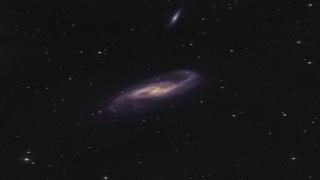Bibcode
Domínguez Sánchez, H.; Martin, G.; Damjanov, I.; Buitrago, F.; Huertas-Company, M.; Bottrell, C.; Bernardi, M.; Knapen, J. H.; Vega-Ferrero, J.; Hausen, R.; Kado-Fong, E.; Población-Criado, D.; Souchereau, H.; Leste, O. K.; Robertson, B.; Sahelices, B.; Johnston, K. V.
Referencia bibliográfica
Monthly Notices of the Royal Astronomical Society
Fecha de publicación:
5
2023
Número de citas
28
Número de citas referidas
20
Descripción
Interactions between galaxies leave distinguishable imprints in the form of tidal features, which hold important clues about their mass assembly. Unfortunately, these structures are difficult to detect because they are low surface brightness features, so deep observations are needed. Upcoming surveys promise several orders of magnitude increase in depth and sky coverage, for which automated methods for tidal feature detection will become mandatory. We test the ability of a convolutional neural network to reproduce human visual classifications for tidal detections. We use as training ~6000 simulated images classified by professional astronomers. The mock Hyper Suprime Cam Subaru (HSC) images include variations with redshift, projection angle, and surface brightness (μlim = 26-35 mag arcsec-2). We obtain satisfactory results with accuracy, precision, and recall values of Acc = 0.84, P = 0.72, and R = 0.85 for the test sample. While the accuracy and precision values are roughly constant for all surface brightness, the recall (completeness) is significantly affected by image depth. The recovery rate shows strong dependence on the type of tidal features: we recover all the images showing shell features and 87 per cent of the tidal streams; these fractions are below 75 per cent for mergers, tidal tails, and bridges. When applied to real HSC images, the performance of the model worsens significantly. We speculate that this is due to the lack of realism of the simulations, and take it as a warning on applying deep learning models to different data domains without prior testing on the actual data.
Proyectos relacionados

Las Galaxias Espirales: Evolución y Consecuencias
Nuestro grupo pequeño esta bien conocido y respetado internacionalmente por nuestro trabajo inovativo e importante en varios aspectos de la estructura y la evolución de las galaxias espirales cercanas. Usamos principalmente observaciones en varias longitudes de onda, explotando las sinergías que nos permiten responder a las cuestiones más
Johan Hendrik
Knapen Koelstra

Huellas de la Formación de las Galaxias: Poblaciones estelares, Dinámica y Morfología
Bienvenida a la página web del g rupo de investigación Traces of Galaxy Formation. Somos un grupo de investigación amplio, diverso y muy activo cuyo objetivo principal es entender la formación de galaxias en el Universo de una manera lo más completa posible. Con el estudio detellado de las poblaciones estelares como bandera, estamos constantemente
Anna
Ferré Mateu